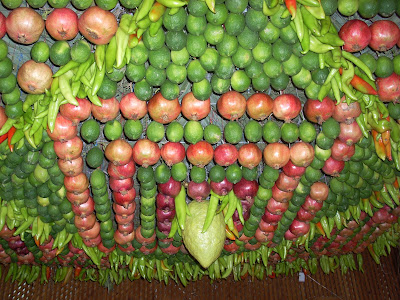Over Chol Ha'moed one of our family trips was to Har Greizim in the Shomron Hills -- to see the "sukkot" of the Shomronim/Samaritans. We learned that their sukkot are different that ours because of persecution by Arabs, and they had to differentiate themselves by "proving" they weren't Jews. Here are some pictures of our trip... (explanations on Samaritans at the links in the bottom of this post)
Note the "schach" above the hanging fruits/vegetables.





How interesting! While we went to visit the Shomronim on Har Greizim, unbeknowest to us, relatives went to visit the Shomronim in Holon (a Coastal-Israel city which is home to the sister community of the Har Greizim Shomronim) Some of their sukkot are indoors, while some are outdoors...(I guess they reverted back to their original tradition, since Arab persecution isn't an issue)








Home of the Samaritan High Priest/Cohen Gadol.

Previous posts (and pictures) of Muqata visits to the Shomronim...here, here, here and here.
Wherever I am, my blog turns towards Eretz Yisrael טובה הארץ מאד מאד

9 comments:
Those pix were very cool.
wow... impressive. guess they have a lot of fruit to eat up after sukkot...
Oh wow, talk about creative! I wonder if they are "shmita" fruits..and do they eat them when the holiday is over?
Beautiful. Thanks for the pics.
i actually met the high priest once in the library
how did you get inside their homes? do you have friends there or are they just very welcoming?
how do the holon samaritans relate to israel? (serve in the idf?)
I've heard that the Samaritans have a different 10 commandments. They change one of them to worship at Har Greizim. Does anyone know which commandment they replace?
Yochanan: I've heard that the Samaritans have a different 10 commandments. They change one of them to worship at Har Greizim. Does anyone know which commandment they replace?
They don't replace any of them. They simply don't count the one that we call #1 ("אנכי ה' אלהיך") as one of the 10. They contend (correctly, according to the simple meaning of the text) that this is a statement of fact, not a mitzva.
I don't know if there's anyone still following this thread, but in case there is: Although it isn't readily apparent from these photos of the Samaritan sukkot as viewed from below, the "main" part of their sukkot is actually the part above the layer of hanging fruits: It consists of lulavim, hadassim, and aravot. This is in accordance with their interpretation of Vayikra 23:40-42; namely, that the purpose of "taking" the arba minim is to build the sukkah with them. This, furthermore, also seems to have been the practice of the Jews in Eretz Yisrael at the time of Ezra and Nehemia (see Nehemia 8:13-18). Ezra and Nehemia also seem to have interpreted "פְּרִי עֵץ הָדָר" as meaning olives, rather than etrogim (as opposed to the Samaritans, who interpret it to mean etrogim, just as we do). Josh Waxman has done a very interesting series of posts on this very subject, which you can read here, here, and here.
Dear 'Lurker':
They don't replace any of them. They simply don't count the one that we call #1 ("אנכי יהוה אלהיך") as one of the 10.
Comment:
You actually believe the 10th Samaritan commandment in the Decalogue is part of the original Torah version? Our Torah isn't the original? If so, you're not a believing Jew. That much is obvious.
Whoever you are, you've either adopted flawed and debunked scholarly arguments claiming their 10th is the original, or you're a Samaritan yourself... I'll have to go in and check your profile.
I warmly propose you study Dr. Adam Zertal's findings validating that the original Torah commanded to set up an alter on Mt. `Aival rather than Gerizim. Those findings pull the rug from under the Samaritan Torah version and scientifically prove it a forgery.
the purpose of "taking" the arba minim is to build the sukkah with them. This, furthermore, also seems to have been the practice of the Jews in Eretz Yisrael at the time of Ezra and Nehemia (see Nehemia 8:13-18).
Comment:
It was the practice of the Eretz Yisra'el Jews in the second half of the 5th century BCE. No "ifs", "buts", or "maybes" about it.
the Samaritans, who interpret it to mean etrogim, just as we do).
Retort:
No no nah... you've misconstrued.
The etrog for the Samaritans is merely one of the "פרי עץ הדר". In Samaritan thought, various seasonal fruit constitute "peree `etz hadar". That's what all those fruit hanging from the frames of Samaritan Sukkot are.
Sincerely,
a Qaraite Jew
Post a Comment